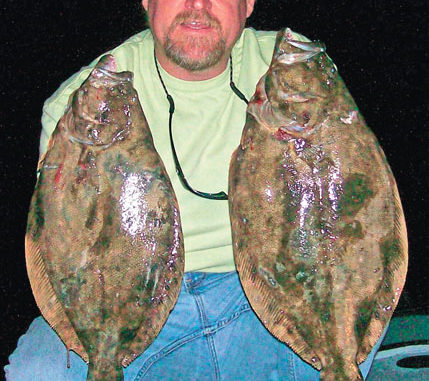
Gigging flounder is a Palmetto State tradition that kicks off this month. Here’s how to poke holes in more fish this year.
Darryl Graham has been “sticking fish” for just about as long as he can remember — but not with a hook.
“I grew up on Isle of Palms and started gigging when I was about 10, going with my dad and a neighbor,” said Graham, who has been stuck on the avocation ever since.
Although it is widely known simply as “flounder gigging,” Graham isn’t one to limit himself — he’s speared everything from spot-tail bass to speckled trout to sheepshead.
But there’s no doubt that the flattened flounder, with its habit of remaining stationary on the bottom even in the wake of boats passing just inches overhead, is the gigger’s bread and butter.
“Flounder will sit right there,” Graham said, oftentimes in mere inches of water.
“It doesn’t take a whole lot of water for a flatfish,” Graham said. “I’ve stuck them before where parts of their backs were sticking out of the water.”
In more than 30 years of gigging, the 41-year-old Graham has “stuck” flounder in every way imaginable. In fact, he became so proficient at it and enjoyed it so much that six years ago, he decided to turn his hobby into a business endeavor — hence, Graham’s Fish Sticker Charters.
Since he lives in Mount Pleasant, the bulk of Graham’s activity focuses in and around the Charleston area. He typically launches his night-time trips from the Isle of Palms, then works his way north along Dewees Island, Capers Island and often on to the Cape Romain Wildlife Refuge and Bulls Bay.
Graham (843-270-666) has actually gigged in Charleston Harbor on occasion and had success, but prefers areas around Charleston that have a bit less boat traffic.
“There aren’t a lot of places in the harbor to get out of wakes,” Graham said. “I usually put in at Isle of Palms and gig up to the north — the (Intracoastal Waterway) and on up.”
Not much definitive information about flounder gigging on the South Carolina coast had ever been gathered, but that began to change a few years ago when the S.C. Department of Natural Resources launched an extensive survey into the practice. Spearheaded by biologist Brad Floyd, the 3-year survey began in 2007. It included three survey methods: intercept surveys on the water, mail surveys and aerial surveys, and it revealed information that will help the SCDNR make future management decisions regarding the species and the sport.
Floyd and graduate student Eric Hiltz visited roughly 50 public boat landings and the surrounding areas at night, interviewing giggers, measuring fish and gathering other data. Using infrared technology, they were able to chart GPS locations for boats that were involved in gigging.
“We could count people in different areas and start getting estimates of where the gigging effort is, where the hot spots are,” Floyd said.
They found gigging activity from Little River to Beaufort and just about everywhere in between. Floyd said that the bulk of the effort was in the Grand Strand area, although admitting that the lack of public boat landings may have concentrated the effort a bit more.
One of the hot spots was North Inlet near Georgetown, where it wasn’t unusual to see 20 boats gigging on a given night, “if the tides were right,” Floyd said.
Indeed, conditions dictate when giggers are on the water and how much success they can expect to have.
Ideal conditions include the last portion of the incoming tide and the first portion of the outgoing tide, preferably on a still, windless night with low-light conditions.
The study showed that gigging trips began an average of 1.7 hours before low tide and that 79 percent of giggers were active when low tide was between 10 p.m. and 2 a.m. Also, 70 percent of giggers were active when wind speeds were five mph or less.
Flounder tend to remain still, even with passing boat traffic, unless there’s a bright night sky above.
“About the only time they’re moving is when you’ve got a big moon,” Graham said. “When it’s a lot brighter than it usually is, I guess the fish think you can see them, and they tend to be more skittish.”
Graham cruises along the shoreline, along the edge of the grass, his well-trained eye focused on detecting even the slightest variation in shape and color on the bottom. And that’s not always an easy task, especially for novice giggers, given the flounder’s penchant for hiding.
“They can look just like the bottom — they’re like a chameleon,” Graham said. “If they’re on shells, they’ll have big spots on them; if they’re on sand they’ll have little white specks on them.
“I look for the whole fish — I look for an outline, something that doesn’t look right. I’m looking for something that looks odd on the bottom.”
And that requires practice.
“It’s definitely something you get better at,” Floyd said. “They can change the pigment in their skin to look like whatever they’re around, so you’re better off looking for eyes or the outline of the flounder. The more you do it, the more you come to know what you’re looking for.”
Indeed, experience pays off for giggers.
“There was a definite correlation between years of experience and the numbers of fish gigged,” Floyd said.
The survey showed that giggers with five or fewer years of experience caught an average of one flounder per trip, while giggers with more than five years caught an average of four flounder per trip.
Flounder may hide themselves in a variety of substrates — mud, sandy or shell bottom — so Graham takes his time when patrolling the shoreline, using a generator and 500-watt halogen bulbs to illuminate what lies beneath.
“Live shell with a fairly soft bottom is pretty good, but they will lay on straight mud and hard sand, too,” Graham said.
Flounder converge on these shallow-water areas to feed. They’re lying in wait, ready to ambush any baitfish that pass by, including mullet, minnows, shrimp, pinfish, spots, croakers and menhaden.
Once he’s located a good-sized flounder — the minimum size limit is 14 inches — Graham positions himself directly above the fish and impales it with a quick thrust of his wooden, 13-foot gigging pole.
“You want to hit them hard enough that the gig goes all the way through ’em,” Graham said, “and that can depend on what kind of bottom they’re laying on. If you hit them in soft mud, sometimes you can push them down into the mud, so you’ve got to be careful. Again, you learn how much to do the more you do it.”
Graham’s goal is to spear the flounder right behind the gills — “and not mess up any of the meat,” he said.
Again, timing dictates success when it comes to gigging.
The gigging season traditionally kicks off in May, although flounder may start showing up in decent numbers in April if the spring has been warm.
“Things really start up once it gets to 75, 76 degrees, which is usually in May,” Graham said. “It’s all dependent on weather and water temperature. When it starts getting cold, they head offshore.”
That usually occurs in October, so Graham and other giggers typically have a full six months of productive gigging.
Although Graham will hit the water “anytime after dark,” the tide is his most important barometer of success.
“It all depends on the tide,” Graham said. “We’ve gone before and been out sitting and waiting for it to get dark. As long as the water is just to the edge of the grass, you can hit the incoming tide and the falling tide, and you’ll usually have a good trip.
“You want to cover as much ground as possible and you want to go with the tide — it makes it a whole lot easier to push the boat. Some nights you may get a limit of flounder on just two or three banks.”
Sometimes there’s no limit in the boat, but there could be a massive flounder at the end of the gig pole. Graham readily remembers the biggest flounder he’s ever gigged – a 13-pound giant that was about 30 inches long.
“It was many years ago in the Intracoastal Waterway,” Graham said. “He was in about two feet of water. I saw the eyes and knew he was big, but I didn’t know exactly how big.”
Graham says that most flounder average in the 15- to 16-inch range, and Floyd’s research bore that out — the average flounder caught by giggers was 16.14 inches.
Whatever the size, Graham remains stuck on his favored pastime of the past 31 years. He’s a “night person,” which comes in handy, but he also finds gigging appealing on many other levels, so he hopes to be gigging for another 31 years.
“You never know what’s going to happen,” Graham said. “You’ve got an idea of what you’re going to see, but you just don’t know how big they’re going to be.
“You might go along one bank and see seven or eight flounder that are all too small to gig, then the next one could be 10 pounds. That’s what’s exciting to me.”

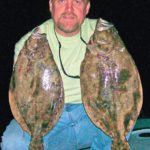
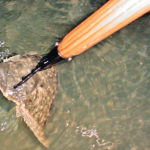
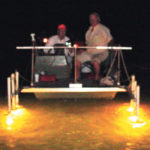
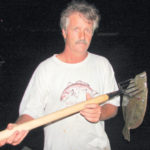
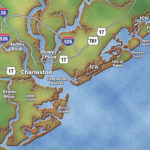
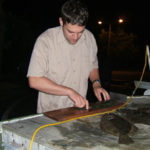



Be the first to comment